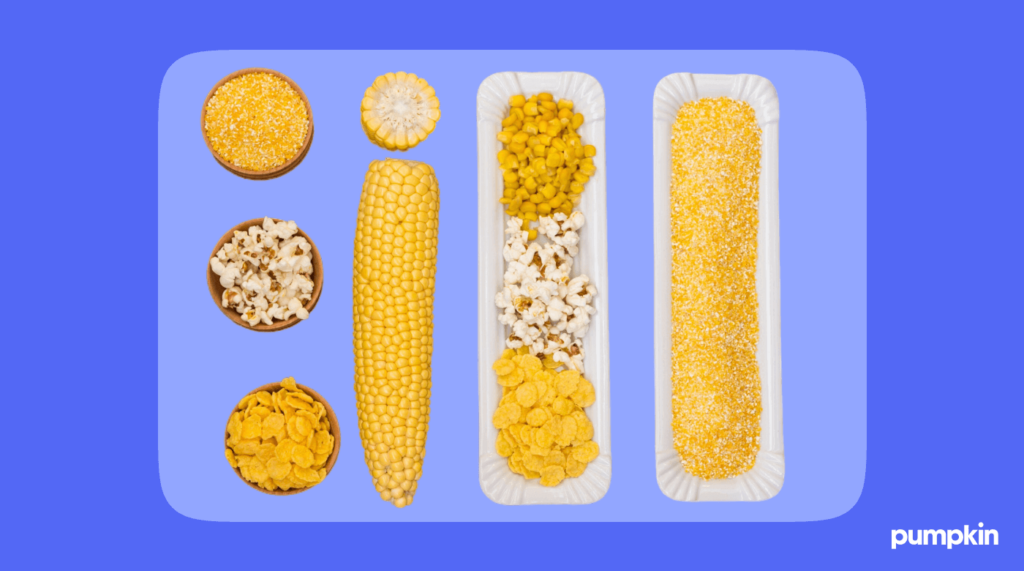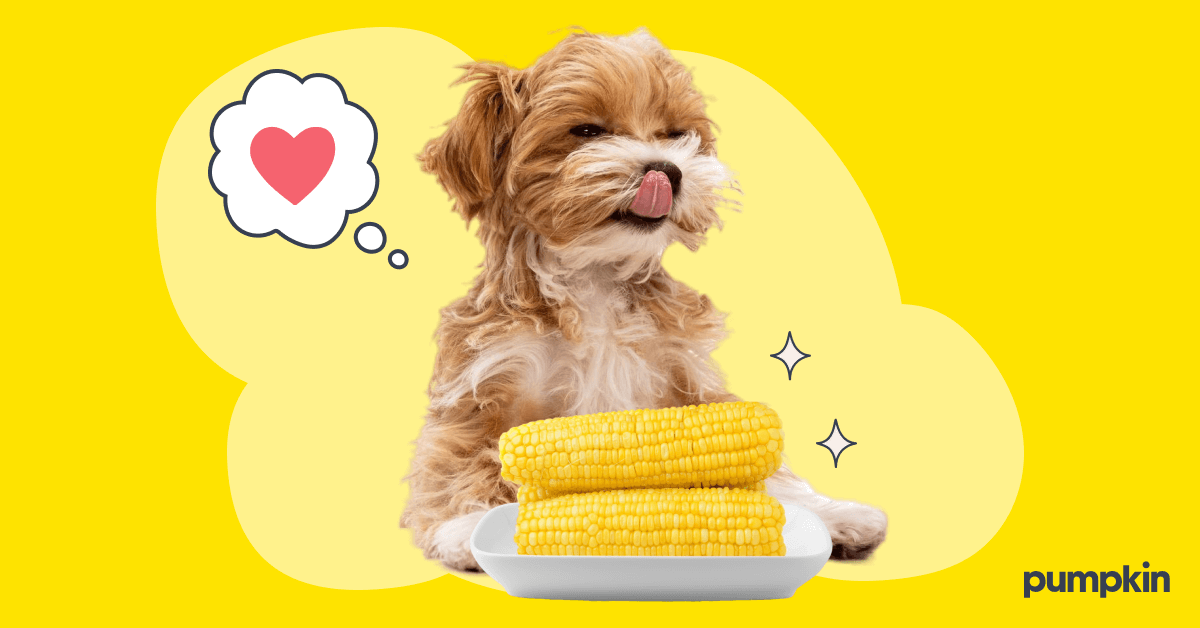Key Points:
- Dogs can safely eat corn kernels when prepared properly, and many commercial dog foods contain corn.
- Corn provides dogs with fiber and healthy fatty acids, but it also contains a fair amount of sugar.
- Dogs should avoid corn cobs and other indigestible corn parts that may cause intestinal blockages.
Picture this: you’re enjoying an ear of corn, and your dog is pleading with their eyes for a taste. We all know the look well.
Pet parents see treats as more than just snacks. They’re little moments of connection, a way to bond, train, and keep our dogs mentally sharp. That’s why sharing food is so tempting to many dog lovers. But is corn a safe treat for your dog?
Dogs can have corn, but it’s not the most healthy treat for dogs. Read on to learn about the health benefits and potential risks of feeding dogs corn, the parts of corn that are safe for dogs to eat, and healthy ways to prepare this food for your pet.
Corn is a moderately healthy treat for dogs
Besides being a rich source of carbohydrates, corn contains higher levels of vitamins and amino acids than grains like rice and wheat. In appropriate amounts, your dogs can enjoy various health benefits from corn:
- Carbohydrates provide energy
- Polyunsaturated fatty acids act as both an energy source and an inflammation buster
- Carotenoids and other phytochemicals help ward off inflammation
- Fiber aids colon health and reduces digestive issues
- Protein and amino acids build muscles
The nutritional value of corn
A single cup of corn is loaded with healthy sources of energy, vitamins, and minerals. Just remember that a full cup of corn is likely too much for your dog (unless you have a very, very big boy).
A cup of sweet yellow corn contains the following nutrients:
- Calories: 125
- Water: 110g
- Protein: 4.74g
- Total fat: 1.96g
- Saturated fat: 0.5g
- Fiber: 2.9g
- Sugar: 9g
- Sodium: 21.8mg
- Magnesium: 53.6mg
- Vitamin C: 9.86mg
Corn offers minerals like magnesium, sulfur, sodium, phosphorus, calcium, iron, potassium, and copper, which keep various organs healthy. Vitamins like riboflavin, thiamine, and vitamin C aid in structural support and energy utilization. These nutrients are as important for maintaining a dog’s health as they are for humans.
However, those 9 grams of sugar are worth keeping in mind when feeding your pup corn, along with the healthy nutrients.
The anatomy of an ear of corn
A corn ear comprises several key parts, each with a different function and nutritional value. The four parts of a corn ear are the kernels, corn silk, cob, and husk.
The easy-to-digest, nutrient-packed kernels are generally safe to eat in moderation. However, corn kernels should be served to pets plain and additive-free to avoid high sodium and sugar levels in their diet. They should also be prepared appropriately before sharing.
The cob, silk, and husk are not safe for dogs to consume.
Risks of feeding corn to dogs
The risks of feeding corn to dogs mostly come from eating the whole cob, eating too much, or eating certain corn-based products.
Weight gain
Because corn contains high levels of sugar, starch, and carbohydrates, it can contribute to weight gain when consumed in large amounts. That’s why it’s important to share corn in moderation (in general, treats should make up no more than 10% of your dog’s daily diet to ensure they stay at a healthy weight).
Some corn treats are healthier than others. For instance, plain, air-popped popcorn is safe for dogs and naturally low in calories. Cooked sweet corn kernels are moderately healthy for pups, so long as they’re free of added sugar, salt, or oils. However, corn on the cob slathered in salt and butter is very unhealthy for your pup, for a variety of reasons.
Choking hazard and intestinal blockages
Corn cobs are dangerous, as they may cause choking and intestinal blockages in dogs. Digestive blockages necessitate immediate veterinary attention.
Signs of digestive issues from corn cob ingestion include:
- Diarrhea
- Constipation
- Lethargy
- Loss of appetite
- Abdominal pain
Corn husks are essentially indigestible to humans and dogs, and so they can cause digestion problems in our pets.
Unsafe corn products
Some products that contain corn may not be healthy for your dog.
For example, corn syrup isn’t safe for dogs because of its high fructose content. Excessive amounts may cause blood sugar spikes and long-term health issues.
Corn chips aren’t a good snack either because they contain other ingredients that can be harmful to dogs, such as salt and oils.

Corn allergies in dogs
Studies show that it’s rare for dogs to develop an allergic reaction to corn (and other grains) compared to animal proteins from beef, dairy, and chicken.
Still, if you have concerns about corn allergies in your dog, you should watch for the following symptoms:
- Itchy paws, ears, face, and belly
- Facial swelling
- Recurrent ear or skin infections
- Vomiting
- Diarrhea
- Lack of energy
Talk to your vet if these symptoms arise after changing your dog’s diet.
Dogs with atopic dermatitis — a condition that makes the skin prone to allergies and irritation — are vulnerable to food allergies in general. Atopic dermatitis tends to run in families. If your dog has it, talk to your vet first before giving them any new treats.
Pet Pro Tip: If you have a dog that is prone to ‘snacksidents’ – you should consider getting a dog insurance plan as soon as possible. It can help you afford the best care in the future by covering eligible vet bills for digestive illnesses, toxic ingestion, and more.
Is corn in commercial dog food okay?
This golden grain has gotten a bad rap because some products (again, we’re looking at you, corn syrup), aren’t good for dogs or humans. But in the right form, corn is packed with perks for pooches. Not only does it help keep their tummies happy and their stools solid, but corn also makes pet food taste good. At least, we think so — we haven’t tried it ourselves.
Understanding dog food labels
Product labels provide essential safety information about commercial dog food. The nutritional analysis (or guaranteed analysis) lists ingredients by quantity, highlighting key components like corn.
Dog food usually features primary proteins (beef, chicken), carbohydrates (corn, rice), meat meals, and beneficial fats (fish oil).
The order in which these ingredients appear is crucial. If corn is listed before protein, it indicates a higher corn content, which may not be ideal for canine nutrition.
Is corn low on the glycemic index?
The glycemic index (GI) measures how quickly foods raise blood sugar levels. Corn meal has a GI of 69. The GI of corn is 53, while chicken and beef have a GI of 0.

Feeding your dog too much corn or dog food that’s high in corn and other grains can increase blood sugar levels more quickly than a diet that’s focused more on healthy proteins for dogs, like chicken and beef.
How to prepare corn for dogs
Corn should be given to dogs after it’s cooked, as cooked corn is more digestible than raw corn.
Sweet, fresh corn should be cooked plain. Added sugars, salts, oils, butter, or seasonings can be harmful to dogs.
Canned corn may be offered as an occasional treat to dogs without blood sugar problems, but only serve canned corn with zero additives.
Corn oil may also be used for cooking homemade treats. Unlike lard, corn oil is rich in heart-healthy, anti-inflammatory polyunsaturated fats and has little effect on weight, blood pressure, and insulin sensitivity.
Corn is a safe treat for dogs
Corn can be a safe, delicious treat for your dog as long as it’s shared in moderation, cooked properly, and served fresh without extra ingredients. (If you’ve already slathered your corn with salt and butter, it’s no longer safe for your pup.)
When exploring new foods with your pup, always be prepared for a potential bad reaction. When the unexpected happens, a dog insurance plan can help give pet parents peace of mind. A pet insurance policy can help you afford top-quality pet healthcare by covering eligible vet bills when future accidents or illnesses arise.
FAQs
- https://www.sciencedirect.com/science/article/pii/S0167587724000497
- https://www.ncbi.nlm.nih.gov/pmc/articles/PMC8870860/
- https://www.thepharmajournal.com/archives/2022/vol11issue7/PartQ/11-6-316-181.pdf
- https://www.intechopen.com/chapters/62653
- https://fdc.nal.usda.gov/fdc-app.html#/food-details/169998/nutrients
- https://www.tandfonline.com/doi/full/10.1080/10408398.2021.1931020
- https://veterinaryevidence.org/index.php/ve/article/view/483
- https://www.ncbi.nlm.nih.gov/pmc/articles/PMC9717738/
- https://www.tandfonline.com/doi/pdf/10.1080/10408398.2021.1931020
- https://avmajournals.avma.org/view/journals/javma/261/S1/javma.22.12.0548.xml?tab_body=fulltext
- https://www.aafco.org/resources/startups/nutritional-labeling/
- https://www.petobesityprevention.org/pet-caloric-needs
- https://www.ncbi.nlm.nih.gov/pmc/articles/PMC9291198/




